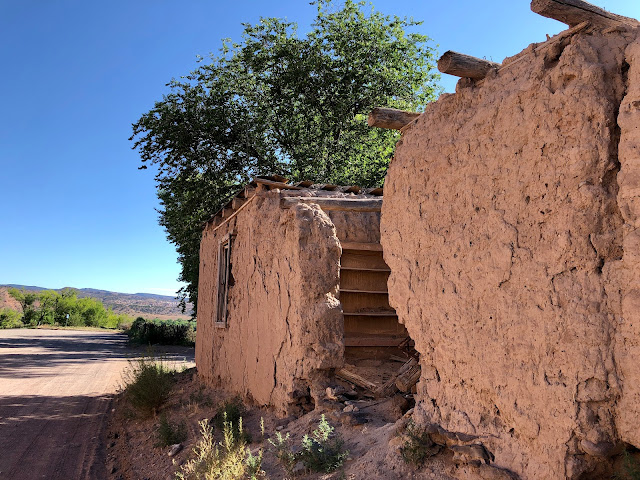We woke up to a cool morning, at 55 degrees. We had a leisurely breakfast and then drove into Abiquiu, and up the hill into the old part of the village. The dirt plaza is fronted by Saint Thomas the Apostle Catholic Church, designed by Santa Fe architect, John Gaw Meem (he designed Los Poblanos in Albuquerque, where we stayed overnight a week ago), and built in 1935, on the site of the original church built in 1756 and burned in 1867. A large territorial home also fronts the plaza, along with a centuries old adobe ruin. Georgia O’Keeffe’s final home is around the corner, overlooking Rio Chama. We took another walk along Rio Chama, then drove along the dirt back road from Abiquiu to Abiquiu Lake. It was a fun morning!
Along the way, we’ve learned about Abiquiu and the Old Spanish Trail. From an historic placque in Abiquiu, “Settled in the 1700’s, Abiquiu was a remote village on the far northern frontier of Spanish America. The Abiquiu settlers were predominantly genizaros - people who by trade, enslavement, or capture had been taken from their Indian families and became part of the Hispanic culture. They were ideally suited to frontier life, exploration, and trade because they spoke several languages and knew the lay of the land.
Generations of Spanish explorers, priests, soldiers, and traders had not succeeded in establishing a trade and communication route between the distant Mexican provinces of California and New Mexico. It was not until well after Mexican Independence from Spain that Antonio Armijo first traveled the whole length of the trail from New Mexico to California.
Abiquiu was not a wealthy village, but in 1829, as trade between the United States and Mexico and within Mexico expanded rapidly, Antonio Armijo knew there was money to be made in opening trade with wealthy California ranchers and church missions. In late fall he led a caravan with 60 men, horses, and pack mules burdened with wool blankets gathered from the surrounding communities and headed to California. He returned the following April with 100 additional horses and mules. The Old Spanish Trail was born. Upon the return of Antonio Armijo, the governor of New Mexico immediately announced the success to his superiors in Mexico City. As a reward, the governor officially named Armijo “Commander for the Discovery of the Route to California.”
Along the way, we’ve learned about Abiquiu and the Old Spanish Trail. From an historic placque in Abiquiu, “Settled in the 1700’s, Abiquiu was a remote village on the far northern frontier of Spanish America. The Abiquiu settlers were predominantly genizaros - people who by trade, enslavement, or capture had been taken from their Indian families and became part of the Hispanic culture. They were ideally suited to frontier life, exploration, and trade because they spoke several languages and knew the lay of the land.
Generations of Spanish explorers, priests, soldiers, and traders had not succeeded in establishing a trade and communication route between the distant Mexican provinces of California and New Mexico. It was not until well after Mexican Independence from Spain that Antonio Armijo first traveled the whole length of the trail from New Mexico to California.
Abiquiu was not a wealthy village, but in 1829, as trade between the United States and Mexico and within Mexico expanded rapidly, Antonio Armijo knew there was money to be made in opening trade with wealthy California ranchers and church missions. In late fall he led a caravan with 60 men, horses, and pack mules burdened with wool blankets gathered from the surrounding communities and headed to California. He returned the following April with 100 additional horses and mules. The Old Spanish Trail was born. Upon the return of Antonio Armijo, the governor of New Mexico immediately announced the success to his superiors in Mexico City. As a reward, the governor officially named Armijo “Commander for the Discovery of the Route to California.”





